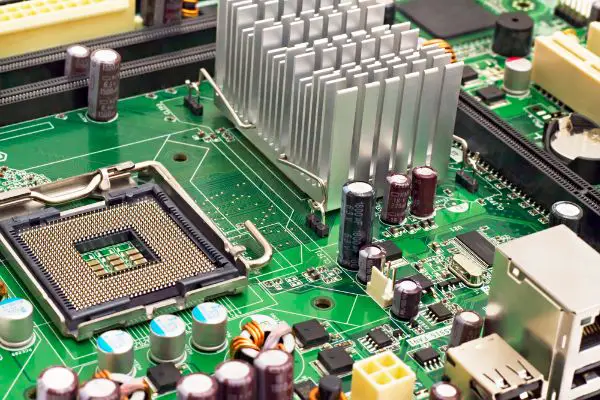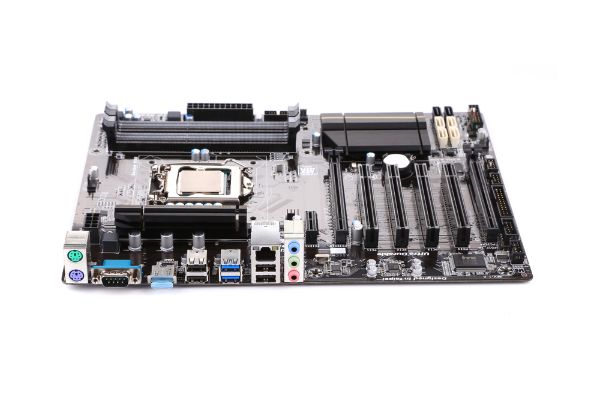Disclaimer: This post may contain affiliate links, meaning we get a small commission if you make a purchase through our links, at no cost to you. For more information, please visit our Disclaimer Page.
For all the things that computers can do for us today, many people might not know about all the parts that are underneath the case. If you’ve ever needed to repair your computer yourself, or if you’ve wanted to build one of your own, you might know about the main components that help the machine run.
The motherboard is one such piece of hardware. It’s a printed circuit board, and it is the main one that your desktop has. Motherboards do a lot for computers, but their main function is to act as a communicator between other hardware in the rig. It sends and receives data that helps other components talk to each other. As you might imagine, no computer is going to run. It represents the very backbone of a PC.
With all that in mind, some users wonder if it is okay to buy a cheaper motherboard, and perhaps one from a lesser brand. This is the topic that we will tackle in today’s article. As we get into the subject, we’ll provide you with some concrete examples of possible disadvantages you might face if you do decide to install a cheap motherboard in your computer.
Conversely, we’ll try to give you some hints as to why it might be better to pay a bit more for a motherboard that has a higher build quality. During our last section, we can go into some details about how the motherboard’s performance might have impacts on other major parts of the system.
Table of Contents
Is It OK to Cheap Out on a Motherboard?
Before we get into specifics on cheap motherboards, we should clarify a couple of things. As you research different boards, you may find that the tech community is divided on just what constitutes a “cheap” motherboard.
Any motherboard that you can find on the market is supposed to be able to perform the hardware’s most basic functions, and you might not necessarily need to spend a lot of money to get what you want. Part of this will depend on your system requirements, and what you want the motherboard to be able to do could be another factor.
As a general rule of thumb, you may be able to get whatever motherboard is the lowest price within your budget, but it still needs to meet a few requirements.
The number one thing your motherboard must be able to do is deliver sufficient power levels to the computer, meaning that it is able to connect and talk to the rest of the hardware.
There are some other things you should keep in mind, but you could say that all other considerations are secondary to this one. If your motherboard cannot handle the power requirements that the system requests, nothing will work, and you will need to spend money again on a different board.
That said, you don’t necessarily need the most expensive board on the market, either. You may pay for a lot of features that you don’t intend to use. This is why we mentioned system requirements and your own intent when we talked about which board to get.
Your first place to look is what other parts you have in your system, and then you’ll figure out the minimum build for the board that should be able to handle talking to those parts. As long as you can do that, the motherboard you pick should be sufficient.
It is difficult to give a sure answer on whether cheaping out on a motherboard is okay, and much of the reasoning will be personal and up to the individual. However, we can say that the answer to this problem is not to go with the absolute cheapest motherboard you can find.
This is one of the most important components in your computer. Try to look for at least a mid-range board that is from a reputable brand, particularly if you can research some of the pros and cons of that brand and its boards. As long as you don’t go for the models that the tech community might consider the very bottom of the barrel, you should be fine with your choice.
However, there is always a chance that even a good motherboard will have a fault in it, and you may need to get a replacement for it.
What Are the Disadvantages of a Cheap Motherboard?
Although motherboard choice does depend on the intent of the user, there are a few things that might be objectively worse the cheaper you go with parts like these. In fact, you may find that much of the community that deals with parts like motherboards for inspections or builds will tell you that a better board is necessary for quality control.
The first problem with a board that is too inexpensive is that it may not handle the requirements that your system requests. This is the most basic disadvantage, and it can be one of the most crucial. If your CPU or GPU cannot talk with the motherboard, they won’t work properly.
If they don’t work, nothing else in the system will be able to get the job done. Before we move on, we will mention here that it is important to research what your system needs. This can give you a better idea of the minimums that you should look for when you shop for a new board.
Next, you may lose access to extra features that you might want. For example, more expensive motherboards might have more IO, and this translates to more USB slots to plug other hardware into the board itself. Additionally, some of the better boards may have improved Wi-Fi reception or capabilities.
Audio connectors are also a big thing that a more expensive board might sport. One of the most important improvements you might be able to get with a better board is more support for RAM storage and the speed with which the CPU can access it.
More RAM means the computer can handle a greater number of more intense applications, such as high-end games. More speed on that RAM means that it can render data faster, making programs run smoother than they might otherwise.
The secondary capabilities of a motherboard could suffer if it is too cheap, as well. When we say this, we’re talking about things like cooling components, heat dissipation, and other things that might help the board perform well. A less expensive board may use materials that don’t do these things as well as other models.
This might not be a bad thing for you, but it all ties back to what you want the board to do. If you are only doing light work on your computer all the time, these factors may not play a huge role.
However, for heavier applications, you want a board that can work hard and stay cool. You may risk failure in the motherboard and other components if you rely on materials that are not up to spec.
Is It Worth Paying More for a Motherboard?
As with many things in the tech world, it depends, but it can be. Do you want to build a system that can handle a lot of background processes or powerful applications at once?
If so, it may make sense to pay more for a better motherboard. A better motherboard might not mean a better system overall, but it does mean that it can handle more powerful hardware that connects to it.
In particular, your central processing unit and your graphics processor are two of the pieces that you might be able to run at more powerful levels with the right motherboard. This means better, faster processing power and higher tier graphics with better textures and frames.
Similarly, a better motherboard can give your system more potential for upgrades. For example, you may not have a powerful computer right now, but a motherboard that can exceed what your processors need is one that you don’t have to replace when you want to put better parts in your PC.
It should already come with the quality and materials it needs to handle upgrades that you might want to make in the future. Some CPUs or GPUs need more slots for RAM, or you might want to make sure you already have a powerful audio card installed on the motherboard.
You can achieve things like this if you decide to get a more expensive model straightaway. Thanks to the better parts that more expensive boards usually offer, you can increase the overall life of your board when you buy a powerful one. The capacitors and other small parts should last longer than those that their cheaper cousins carry.
Can a Motherboard Bottleneck a GPU or CPU?
Yes, it is possible for a motherboard to bottleneck either of these components.
This problem has to do with a specific part of the motherboard known as the PCIe slot. When you get something like a graphics card, it will go into one of these slots on the board.
If you have a high-end card coupled with a board that doesn’t have a good enough PCIe interface, you might experience a slow system when you are playing games or doing other resource-intensive tasks. Further, if you have a board that uses poor voltage regulation, it may overheat, slow down, or cause the other parts to fail.
Conclusion
There is nothing particularly wrong with an inexpensive motherboard, but it needs to be able to handle the other components in your system. As long as it can deliver the proper power levels, it should be fine.
However, you will get more features, and a better capacity for upgrading your system later, if you spend a bit more. Further, the materials manufacturers use in better motherboards should help it last longer.


